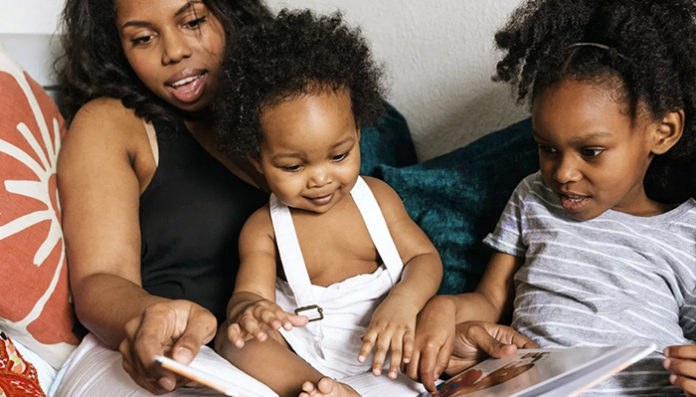
I sing to my son to wake him up in the morning.
“Wake up for me Mylen… It’s time to go to school.”
It’s to the tune of Mary J. Blige’s hook in the song “Come Close” by Common. He waits for the song before he deigns to get out of bed. Even though the light is on, the blinds are open, and I’ve gently tickled his body to rouse him from rest, he waits for the song.
This is how we’ve begun the last 5 school days: singing, getting ready, and then waiting: waiting for the drop-off line at his elementary school to slowly snake around the side of the building and over two speed bumps where he is retrieved by a teacher — literally retrieved.
On the first day of school, the masked teacher whom I’d never met and couldn’t even call by name opened my son’s door, unbuckled his seat belt, and whisked him away from me so quickly I was jarred — scared, even.
There was no goodbye hug, no goodbye kiss or pep talk, no high five. He was just gone. I took one deep breath to clear the immediate anxiety registering in my body and another breath of relief because he was finally in school — something I’d been wanting since March.
For working moms, to have it all often means we have to do it all
The ongoing COVID-19 pandemic has revealed a lot about our society, our country, our systems, and who we are as a people. What I’ve seen is that we are still a nation of unjust, inequitable, and divided adults trying to achieve parity for our children.
But that climb up the steep ladder toward equality — of race, gender, and class — has proven to be less of a climb up each successive rung, and more of a slog through the thick, viscous mud of everything that keeps us apart
Since women entered the workforce en masse during World War II we have been working a second shift at home after the workday is over. Sarah LaChance Adams, PhD, who specializes in ethics and feminist philosophy at the Florida Blue Center for Ethics, says this second shift contributes to the romanticization of the mother-child relationship.
“The romanticization of that relationship is problematic in a lot of ways,” LaChance Adams said. “It allows our society to get a lot of free labor out of women, it allows men to get out of a lot of labor.” That labor is the rearing of children and taking care of the household — tasks that often fall solely on women, even if there’s a man present.
A United Nations policy report issued in April — when lockdowns across the vast majority of the United States had just begun — entitled The Impact of COVID-19 on Women noted that women spend “three times as many hours as men in unpaid care and domestic work, limiting their access to decent work.” This has only been exacerbated by the pandemic.
The report found:
“As women take on greater care demands at home their jobs will also be disproportionately affected by cuts and lay-offs. Such impacts risk rolling back the already fragile gains made in female labor force participation, limiting women’s ability to support themselves and their families, especially for female-headed households.”
Jessica Grange, a fifth grade reading and social studies teacher in Washington, D.C., considered removing herself entirely from the workforce. She considered using medical leave to focus on her son’s education for this school year — a decision she quickly had to walk back.
“Medical leave only covers 66 percent of your salary,” Grange said. “If you’re a single parent like I am, 66 percent of your salary is not going to make ends meet.”
So now she is grappling with preparing to teach reading and social studies to fifth graders during the day, while also making sure that her 4-year-old is plugged in for his preschool virtual learning.
This dynamic is tough in a single-parent household like Grange’s, where she is the only one present to work and parent. In a two-parent household, where both parents are working from home, if only women are doing the domestic work, that challenge is magnified, adding insult to injury.
More stress at home puts women at greater risk
The career and economic loss women are facing or dealing with right now is only one factor of instability, insecurity, and inequity revealed by the pandemic. The question of safety for women and children is even more stark and malevolent.
LaChance Adams says the added layer of stress working parents feel right now worries her, because it could lead to unchecked violence against women and children.
“When women are economically dependent they’re extremely vulnerable. They don’t have a way to escape from abusive situations. When women are trapped, under pressure, and don’t have resources to take care of their children, sometimes that frustration is then visited upon the children themselves. And when we don’t have children going to school and activities every day, then we don’t have anyone checking on them and seeing if they’re okay. That terrifies me.”
We’ve solved the child care problem before, we can do it again
LaChance Adams suggests federal support for child care: a solution that is not foreign to the United States.
“It was during World War II that the government provided child care for women so that they could go work and help the war effort. I don’t think that we should have to have a war for that kind of social support to exist.”
Such social support is available in some other developed nations such as Sweden. It is also available in the United States through a tax write-off for companies who subsidize child care under Form 8882 the Credit for Employer-Provided Child Care.
When I was pregnant with my son there were at least five other women at my job who were all pregnant at the same time. We all planned to take the 12 weeks of maternity leave (6 weeks paid, 6 weeks unpaid) before we returned to work. However, once we returned to work we all had to find adequate child care.
Finding the right day care center for your child is difficult. They’re not all created equal. For $1,200 a month one day care promised to teach my son baby sign language and yoga, and offered many other amenities that a 3-month-old probably wasn’t going to need. But look at that price tag: $1,200 a month is a mortgage for some.
Finding affordable child care for a child that was not public school age was difficult enough pre-pandemic.
The advocacy organization Child Care Aware found in their 2019 report The US and the High Price of Child Care that, on average, families in the United States spend between $9,100 and $9,600 annually on child care for children 5 and under. However, this national average only tells part of the story as child care prices range by state.
When my husband and I were looking for day care centers for our son, I often remarked in jest how we needed scholarship programs for infants to go to day care like we have for young adults going to college.
But this brings me to the crux of the issue. When it comes to public school, though its primary function is education, its secondary function is —undeniably — affordable child care.
Public school can’t be our only solution
The pandemic eroded (and for many, removed) a basic premise of life in modern America: public school as child care. With paid, extended-day programs, schools open their doors as early as 6 a.m. and close as late as 6 p.m., allowing parents to work a variety of shifts.
But COVID-19 has forced children to learn from home, where the majority of them will need to be under the watchful eye of an adult. If they weren’t already a stay-at-home parent, that adult is presumably either working from home, has left the workforce due to layoffs, or chose to support their child because the cost of child care is too high.
COVID-19 has not only revealed how critical affordable child care is to our civilization but also how difficult, time-consuming, and aggravating teaching really is.
The viral video of child actor Ramon Reed singing and preaching at his virtual-learning desk when he should have been focused and paying attention to school elicited lots of laughs and views.
After I giggled over the video myself I wondered about his mother, who could be heard in the background nagging him to get on task. Does she deal with this every day? I thought.
My own experience of teaching my child to read, add, and subtract while constantly telling his 5-year-old self to sit still, pay attention, and get focused was enough to stress me out.
Then there were weekly calls from my 13-year-old nephew to help him with essays and PowerPoint presentations for his seventh-grade homework because his parents were working and his grandmother (my mother) was trying to hold her mule as he worked her nerves.
As Grange said, “I think that parents have a greater appreciation for teachers now.”
Gone is the notion that teachers are well-paid babysitters. I think as parents we can all agree teachers are grossly underpaid for educating and dealing with our children every day.
Yet, here in this realization of what the pandemic has wrought on our lives there still remain very few solutions.
We all must demand change — fathers especially
Schools across the country at every level of education are opening slowly to in-person learning. And just as quickly as they are opening their doors to students, they’re reporting positive COVID-19 cases among teachers and students.
Some parents are sending their children to school out of necessity. Others are keeping their children home out of necessity. And still, we have come no closer to addressing the crisis of child care — in or out of the pandemic. LaChance Adams believes the solution may sound revolutionary but is actually quite simple.
“Really, it’s collective action that makes a difference,” she said. “This impacts all of us. People think child care is just a women’s issue. It’s preposterous! It affects everyone!”
Grange understands that as long as the child care crisis is only seen through the lens of being a women’s issue it will never be addressed by the collective.
She said, “More than likely it’s going to take fathers to be voices [of change] in their workplaces, because they’re not going to listen to [women]. Yeah, we could fight, fight, fight. We can rally, we can complain, we can sue. But if fathers took [ownership] and said, ‘No, we’re all parents here and we all need [child care],’ I think that things would probably [change].”
However her confidence in that happening is low. She concluded her sentiment by saying, “But what’s the likelihood that’s going to happen?”
Women still feel like they have to choose
between work and family
My husband and I made the decision to send our son to school. My husband questioned the decision as COVID-19 cases in Florida skyrocketed this summer, but as a working mom, I was adamant. Even though the school orientation was virtual, I was adamant.
From March through August, my 5-year-old had been with me all day, every day with the exception of the few weeks we tried summer camp in late June and July. By September, he needed to go to school and more importantly I needed him to go to school.
I did not want to sacrifice my work as a creative entrepreneur, a new journey I began last year after leaving my broadcast news career of 11 years. I did not want to put my business on pause to sit with my 5-year-old in front of the computer screen 5 days a week from 8:30 a.m. to 3 p.m. (because that’s the expectation) to make sure he was engaged in virtual school.
“It’s important to get away and have a break,” LaChance Adams said. “It’s important for mothers, in particular, to still remain individuals who have their own needs and thoughts. [They] should have a chance to continue their friendships, to think for themselves, to have quiet space for their minds, [and] to explore their own interests that have nothing to do with being mothers.”
As we all continue to navigate this new space of parenting, educating, and working in a pandemic while also trying to solve the child care crisis that has plagued us for years, it’s evident that all the shareholders involved need to look at this issue as a societal ill and not simply women’s work.
As for me, this morning I dropped off my son at school and was able to open the door for him. Before he ran off to get his temperature taken he said, “Oh, Mom. Wait,” and then he wrapped his arms around me and hugged me goodbye.
In that moment I was glad. Even though times have changed and mask-wearing is mandatory, and even though the adults have myriad worries about “the ‘rona,” my son is adjusting. We’re finding a degree of normalcy in what can only be described as abnormal times.
Medically reviewed by Karen Gill, M.D.
Written by Nikesha Elise Williams on September 17, 2020
Source: healthline.com










